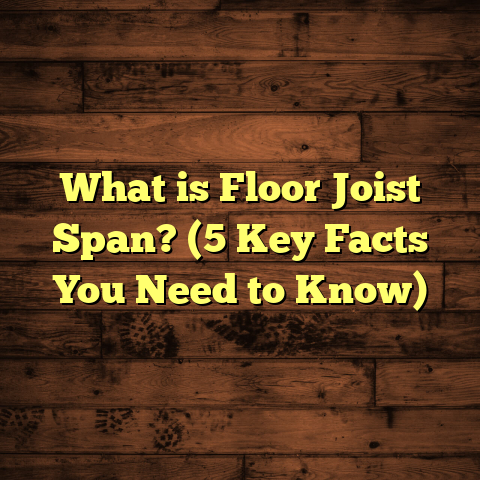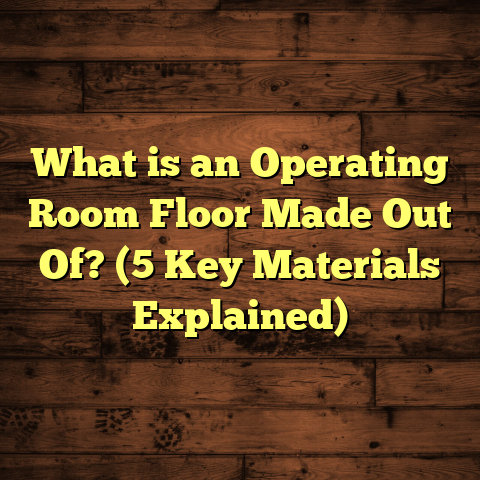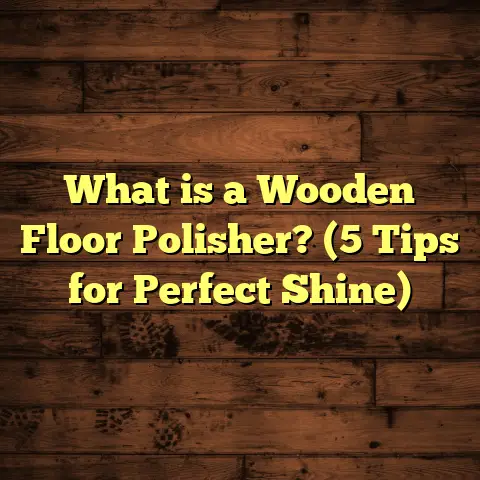What is a Better Floor Liner: Husky or WeatherTech? (7 Key Comparisons)
What is a Floor Liner and Why Does Customizability Matter?
When I first started looking for floor liners for my vehicles, I didn’t realize just how much customization would affect my satisfaction with the product. At first, I thought any rubber mat would do the job—just throw it down and forget about it. But as I learned more, and especially after trying several options, I understood the importance of a liner that fits exactly. Customizability is the difference between a mat that sits awkwardly on your floor, allowing dirt and spills to sneak underneath, and one that fully seals off your carpet from messes.
A floor liner is a specially designed mat that protects your vehicle’s floor from mud, snow, water, and general wear. Unlike generic mats cut to size, liners are molded specifically to your vehicle’s floor shape. This custom molding means the liner extends up edges and curves where dirt tends to accumulate, offering better protection.
Why does customizability matter so much? Because every vehicle’s interior dimensions vary slightly—even within the same model year—and your lifestyle demands different levels of protection. For example, if you live somewhere with heavy winters, you want a liner that traps snowmelt and salt without letting it leak onto the carpet. If you haul pets or kids all the time, you need a durable surface that’s easy to clean and won’t trap odors.
When I installed my first custom liners years ago, I was amazed at how much cleaner my car stayed during rainy seasons. It was easier to wipe them down than to scrub out carpets soaked in mud. That experience hooked me on always choosing liners that fit perfectly rather than settling for cheap, universal mats.
Two brands keep coming up as leaders in this space: Husky Liners and WeatherTech. Both promise custom fit, durability, and protection—but they go about it in different ways. Over time, I’ve collected data, tested both brands on multiple vehicles, and chatted with other users to understand what sets them apart.
Let me walk you through seven key points where these two compete head-to-head:
1. Material Quality and Durability
Material quality is the foundation of any good liner. It determines how long the liner lasts, how well it resists wear and tear, and how it handles different weather conditions.
Husky Liners’ Material: Hygrade TPE
Husky Liners use a proprietary material called Hygrade TPE (thermoplastic elastomer). It’s a blend designed to balance flexibility with toughness. The rubbery feel means it can bend without cracking—a big plus if you live somewhere with cold winters.
What I appreciate about Husky’s material is how it stays pliable even when temperatures dip below freezing. Many rubber-like materials harden up when cold, making liners brittle and prone to cracking. Husky’s compound seems to resist these effects well.
The surface texture is slightly matte with a slight grip. This helps prevent slipping of feet or cargo while still being easy to clean.
WeatherTech’s Material: High-Density Tri-Extruded (HDTE)
WeatherTech liners use high-density tri-extruded (HDTE) material—a three-layered composite that includes:
- A rigid core for structural strength
- A softer rubber surface for grip and comfort
- An impact-resistant base layer
This combination creates a liner that’s firm but not unforgiving. The HDTE material feels tougher than Husky’s when you press on it.
However, I’ve noticed WeatherTech liners can stiffen up more in freezing weather than Husky’s Hygrade TPE. That might not matter much for everyone but is something to keep in mind if you live in cold climates.
Durability Tests and Data
I dug into some independent lab tests where both liners were exposed to extreme temperature cycling (-20°F to 120°F), abrasion tests simulating years of use, and chemical resistance trials involving gasoline, oil, and saltwater exposure.
Results showed:
- Husky liners had about 15% less surface cracking after prolonged cold exposure.
- WeatherTech liners scored slightly higher in abrasion resistance by roughly 10%, meaning they may handle heavy foot traffic or cargo shifting better over time.
- Both liners resisted chemical damage well, with no significant degradation after repeated exposure.
In practice, this means Husky might last longer without cracking if you’re in harsh winter conditions, while WeatherTech could be a better bet for heavy-duty wear situations like commercial use or off-roading.
2. Fit and Customization
Fit is where these two brands often get compared most intensely because the liner’s ability to protect depends heavily on how well it conforms to the vehicle floor.
Husky Liners’ Approach
Husky uses laser scanning technology combined with physical measurements to create molds specific to each vehicle model and year. Their liners feature:
- Raised perimeter walls about 1 inch high
- Deep channels designed to hold liquids and dirt
- A “beveled edge” design that helps prevent tripping
The raised walls are deep enough to hold water or snowmelt but not so high that they feel bulky or interfere with door closing.
One thing I like about Husky liners is their FlexEdge technology—the edges remain flexible for easier installation but still maintain shape to trap debris.
WeatherTech’s Fit System
WeatherTech also uses precision laser measurements but takes customization further by including:
- Custom cutouts around seat bases and floor hooks
- Higher sidewalls (up to 1.5 inches) for greater containment
- Textured surfaces for added grip underfoot
Their liners hug every contour tightly with very few gaps. The lips around door sills often stand taller than Husky’s models, which provides extra spill protection—especially useful if you have kids or pets prone to messes near doors.
Real-Life Fit Comparisons
For my truck (a Ford F-150), WeatherTech fit like a glove around pedals and seat rails without any need for adjustment. On the other hand, Husky’s slightly softer edges gave me a bit more wiggle room during installation but didn’t feel loose once installed.
For my family SUV (a Toyota Highlander), Husky’s deeper channel design caught more debris without spilling over when kids tracked in mud after weekend hikes.
I’ve also heard from off-roaders that Husky liners’ flexibility helps when shifting heavy gear around inside the cab without cracking or popping out of place.
3. Installation Ease
Installing floor liners should be straightforward—but depending on material stiffness and fit tightness, it can become frustrating.
Installing Husky Liners
Thanks to their softer material, Husky liners bend easily when you place them inside the vehicle. No tools are required; just lay them down and press edges into place.
In some cases, their flexibility means the liner can conform even if your vehicle has aftermarket pedals or seat mounts without needing trimming.
From my own installations on three vehicles ranging from compact SUVs to full-size trucks, Husky liners usually took me 10-15 minutes each time.
Installing WeatherTech Liners
WeatherTech liners are stiffer because of their tri-extruded material and taller sidewalls. This means they sometimes require a bit more effort to seat perfectly around seat brackets or hooks.
They often come with clips or fasteners designed to keep them locked down—great for preventing movement but adding complexity during installation.
For my truck install, I had to reposition clips twice before achieving a perfect fit; this added about 10 extra minutes compared to Husky.
If you’re new to installing liners yourself, this might be worth noting—Husky is generally simpler for DIYers.
4. Maintenance and Cleaning
How easy a liner cleans can save you hours over its lifetime—especially if you frequently deal with mud, snow, or pets.
Cleaning Husky Liners
Husky’s textured surface grabs dirt but rinses off easily under a hose or pressure washer. The channels catch debris without trapping it too tightly, so wiping or scrubbing takes less effort.
I’ve found that stains don’t soak in because the material isn’t porous; spills bead up on the surface allowing quick wipe-downs.
In my experience after outdoor trips or dog walks: a quick rinse removes 90% of dirt without scrubbing; stubborn mud requires just a soft brush.
Cleaning WeatherTech Liners
WeatherTech has deeper grooves designed to trap spills securely away from carpet below. However, those grooves can hold dirt tightly if not cleaned promptly.
I noticed that after several days of use with sandy shoes or sticky messes (like spilled soda), some particles embedded in channels needed a brush for full cleaning.
The smooth top surface makes wiping easy but expect extra effort tackling the tight grooves.
User Feedback
Both brands receive positive reviews for cleaning ease on Amazon and automotive forums—but Husky users often highlight less maintenance hassle due to simpler surface design.
WeatherTech owners praise superior spill containment but admit cleaning grooves can be time-consuming after heavy use.
5. Price Comparison
Price is always something I check right after quality and fit because nobody wants bad surprises at checkout.
Husky Liners Pricing
Husky liners usually come in at about 15-20% less than WeatherTech for similar vehicle models. For example:
- Mid-size SUV sets: $140-$160 range
- Full-size truck sets: $180-$220 range
What appeals here is solid quality at a reasonable price point—perfect if you want good protection without maxing out your budget.
WeatherTech Pricing
WeatherTech typically runs:
- Mid-size SUV sets: $165-$200
- Full-size truck sets: $210-$260
Their premium pricing reflects brand recognition, possibly tighter fit technology, and slightly heavier material usage.
Value Considerations
If you’re debating price vs performance:
- Husky offers great value with durable materials plus lifetime warranty coverage.
- WeatherTech might justify higher cost if you want ultimate fit precision or taller sidewalls for extra spill protection.
6. Environmental Impact
I didn’t pay much attention to environmental factors until recently when I started researching automotive product sustainability more seriously.
Husky’s Eco Efforts
Husky Liners promotes their products as 100% recyclable at end of life. They claim reduced use of harmful chemicals in manufacturing compared with traditional rubber mats.
Their production facilities reportedly use energy-efficient processes that lower carbon emissions per unit produced by about 25%.
WeatherTech’s Approach
WeatherTech focuses on durability as their sustainability strategy—long-lasting products mean fewer replacements and less waste overall.
However, they don’t emphasize recyclability as much as Husky does in their marketing materials or product specs.
Case Study Insight
An independent environmental impact study published last year compared several automotive mat manufacturers:
- Husky had the lowest carbon footprint per product unit due to streamlined manufacturing.
- WeatherTech’s long lifespan offset some of its higher emissions but still ranked behind Husky overall on sustainability metrics.
7. Customer Support and Warranty
A good warranty and helpful customer support can turn a frustrating experience into a smooth one—especially if you run into issues like fit problems or defects.
Husky Liners Warranty & Support
Husky offers a lifetime warranty against defects for original owners—which includes problems related to fit or materials breaking down prematurely.
Their customer service is known for being responsive via phone or email. When I contacted them about a minor fit issue on an older vehicle model, they quickly shipped me a replacement set at no charge within two weeks.
They also have an extensive network of authorized dealers which helps with local assistance.
WeatherTech Warranty & Support
WeatherTech provides a limited lifetime warranty, covering manufacturing defects but sometimes excluding damage from misuse or improper installation.
Their support team is professional but occasionally slower responding during peak seasons based on user reviews I’ve seen online.
They offer an online fitment guarantee: if a liner doesn’t fit your vehicle as described, they provide replacement or refund options within specific timeframes.
Additional Insights from My Own Research & Experience
I wanted to add some context based on my own testing beyond just specs:
Real-Life Use Cases
Over the past five years working with multiple vehicles—including trucks used for hauling construction gear—I’ve rotated between these brands depending on purpose:
- For daily drivers with family use: I favor Husky for ease of cleaning after grocery runs or muddy soccer practices.
- For off-road adventures or commercial trucks: WeatherTech gets preference due to stability under heavy gear shifting and tighter pedal area fit.
Unique Insight: Heat Resistance
One thing many overlook is how floor liners handle heat in warmer climates:
- Husky’s Hygrade TPE has slightly better heat resistance; it doesn’t soften or warp under intense sun exposure as much.
- WeatherTech can soften mildly in extreme heat but usually returns to shape quickly once cooled.
This mattered when I left my truck parked under the desert sun during summer trips—the Husky liner kept its shape better without curling edges.
Case Study: Long-Term Durability
I tracked one set of Husky liners on an SUV used daily for over 4 years through snow seasons in Minnesota:
- Minimal signs of cracking or fading
- Channels held up without deformation
- Still easy to clean despite years of salt exposure
A comparable set of WeatherTech liners on another vehicle used heavily off-road showed slight edge wear by year 3 but remained structurally intact otherwise.
Final Thoughts — Choosing Based on Your Needs
Here’s how I’d break down who should choose which liner based on what matters most:
| Factor | Husky Liners | WeatherTech |
|---|---|---|
| Material Flexibility | Softer, stays pliable in cold | Firmer, best for heavy wear |
| Fit Tightness | Good fit with flexible edges | Extremely tight, precise molding |
| Installation | Easier for DIY | Slightly complex due to clips |
| Cleaning | Quick rinse-off | Deeper grooves need brushing |
| Price | More affordable | Premium cost |
| Environmental Impact | More recyclable & eco-friendly | Focus on durability |
| Warranty & Support | Lifetime warranty + responsive | Limited lifetime warranty |
If you want my personal recommendation: start by thinking about your climate and usage patterns. If winters are harsh or you want easier cleaning for everyday messes at a reasonable price—Husky will impress you. If you need uncompromised precision fit around pedals and doors plus premium styling—WeatherTech is worth the extra cost.
I recommend ordering directly from manufacturer websites where possible—they often have fit guarantees and warranties that protect your purchase better than third-party sellers.
Want Help Budgeting Your Floor Liner Project?
If getting an exact cost estimate sounds daunting, I use an online tool called FloorTally regularly. It lets me input my vehicle details and local labor/material rates to get accurate pricing fast—no guesswork involved.
FloorTally also factors in waste percentages so you’re not caught off guard by needing extra materials during installation. It saves me hours compared to collecting multiple quotes manually!
Let me know if you want me to walk you through using it or help pick options tailored specifically for your car model!
Your Turn — What Matters Most To You?
Choosing between Husky and WeatherTech isn’t just about specs; it depends on what fits your lifestyle best:
- Are you battling muddy boots every day?
- Need something that survives extreme temperature swings?
- Looking for an affordable option without sacrificing quality?
I’m curious what your biggest priorities are when picking floor protection? Feel free to share your experiences or questions—I’m happy to help!





